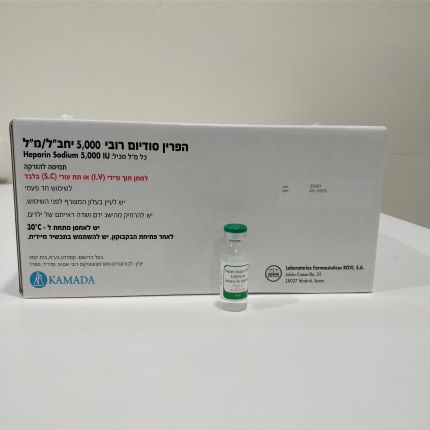Quest for the right Drug

הפרין סודיום רובי 5,000 יחב"ל/מ"ל HEPARIN SODIUM ROVI 5,000 IU/ML (HEPARIN SODIUM)
תרופה במרשם
תרופה בסל
נרקוטיקה
ציטוטוקסיקה
צורת מתן:
תת-עורי, תוך-ורידי : S.C, I.V
צורת מינון:
תמיסה להזרקה : SOLUTION FOR INJECTION
עלון לרופא
מינוניםPosology התוויות
Indications תופעות לוואי
Adverse reactions התוויות נגד
Contraindications אינטראקציות
Interactions מינון יתר
Overdose הריון/הנקה
Pregnancy & Lactation אוכלוסיות מיוחדות
Special populations תכונות פרמקולוגיות
Pharmacological properties מידע רוקחי
Pharmaceutical particulars אזהרת שימוש
Special Warning עלון לרופא
Physicians Leaflet
Pharmacological properties : תכונות פרמקולוגיות
Pharmacodynamic Properties
5.1 Pharmacodynamic properties Pharmacotherapeutic group: antithrombotic agent ATC code: B01AB01 Heparin is a mucopolysaccharide polysulphate ester and consists of glucosamine-N-sulphuric acid and sulphate esters of glucuronic acid, which are linked to each other through glycosidic bonds. Because of its strong negative charge, heparin forms complexes with certain proteins and thereby alters their biological properties. This applies above all to antithrombin III (ATIII), which experiences an approximately 700-fold increase in activity as a result of complex formation with heparin. Activated ATIII brings about inhibition of serine proteases, which include the clotting factors XIIa, XIa, Xa, VIIa and IIa. Factor VIIa is relatively weakly inhibited by the heparin-ATIII complex and factor IIa (thrombin) is inhibited by it to a particularly marked extent. Even low heparin doses accelerate inhibition of factor IIa (thrombin) and factor Xa by ATIII. This explains the prophylactic effect of low-dose heparin for the prevention of thromboembolic disorders. The anticoagulant effect primarily depends on the amount of ATIII available and the fibrinogen concentration; some substances contained in platelets (platelet factor 4) likewise neutralise the effect of heparin. In addition, high heparin doses inactivate any excess thrombin and thus prevent fibrin from arising from fibrinogen. Heparin also influences platelet functions.
Pharmacokinetic Properties
5.2 Pharmacokinetic properties Heparin can be administered subcutaneously or intravenously. Heparin is not absorbed from the intestine because of its molecule size and negative surface charge; absorption by inhalation is possible. The effect of heparin sets in immediately after intravenous administration, and within 20-30 minutes after subcutaneous injection. Bioavailability after subcutaneous injection varies between individuals. After subcutaneous administration of 5,000 IU of heparin twice daily, plasma levels of between 0.02 IU/ml and 0.8 IU/ml have been measured. The half-life varies a great deal between individuals; the mean half-life is stated as 90-120 minutes and depends on the dose and on liver and kidney function, as well as co-morbidity. Heparin is highly bound to plasma proteins (LDL, globulins [especially ATIII] and fibrinogen); the volume of distribution in adults is stated as being about 0.07 l/kg. After parenteral administration, heparin is eliminated from the bloodstream by uptake into the reticuloendothelial system, by cleavage in the liver (heparinases) and by excretion in urine mainly as depolymerised, inactivated heparin. Heparin excretion takes place by both glomerular filtration and tubular secretion.

שימוש לפי פנקס קופ''ח כללית 1994
לא צוין
תאריך הכללה מקורי בסל
לא צוין
הגבלות
לא צוין
מידע נוסף
